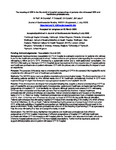The meaning of CPR in the life-world of hospital: perspectives of patients who witnessed CPR and healthcare professionals.
| dc.contributor.author | Fiori, M | |
| dc.contributor.author | Coombs, M | |
| dc.contributor.author | Endacott, R | |
| dc.contributor.author | Cutello, CA | |
| dc.contributor.author | Latour, Jos M | |
| dc.date.accessioned | 2022-07-10T12:39:41Z | |
| dc.date.available | 2022-07-10T12:39:41Z | |
| dc.date.issued | 2022-07-02 | |
| dc.identifier.issn | 1474-5151 | |
| dc.identifier.issn | 1873-1953 | |
| dc.identifier.uri | http://hdl.handle.net/10026.1/19399 | |
| dc.description | File replaced (incorrect version) on 11/7/22 by KT (LDS). | |
| dc.description.abstract |
Abstract Funding Acknowledgements Type of funding sources: Other. Main funding source(s): Resuscitation Council (UK) Background Cardiopulmonary resuscitation (CPR) in hospital is a stressful experience for patients who witness it and for the healthcare professionals involved. Limited evidence and guidance exist regarding the experience of witnessing a fellow patient’s CPR. Informed by a systematic review [1] and a multi-stakeholder consultation [2], the WATCH (Witnessing an Attempt of CPR in Hospital) study has explored the lived experiences of hospital patients and healthcare professionals on patient-witnessed CPR with the primary aim of understanding the impact of such an experience [3]. Purpose The purpose of this study was to understand the meaning of CPR in the context of the hospital life-world of patients who witness CPR and of healthcare professionals. Methods The WATCH study used a qualitative descriptive phenomenological design. The lived experiences of 16 witnessing patients admitted to nine clinical wards and of 20 healthcare professionals involved in CPR were explored through in-depth interviews and focus groups conducted in one hospital in the UK. Results Three themes were developed from analysis indicating that, despite a shared understanding of CPR as part of hospital life and as a potential result of emergencies, patients and healthcare professionals had different perspectives of hospital CPR. 1) Unfamiliarity vs Exposure: although patients were aware of CPR, witnessing CPR was often unexpected and traumatic, as many had not experienced it before. Instead, healthcare professionals with previous knowledge and expertise, held an emotional distance and focused on the clinical tasks of CPR. 2) Fiction vs Reality: healthcare professionals considered patients to have unrealistic expectations of CPR, often uninformed and influenced by distorted portrayal of CPR to the lay public through television. Patients acknowledged that witnessing hospital CPR helped their understanding of the reality of it, which differed from their initial idea. 3) Life vs Death: Patients felt disturbed by the presence of a dead body in their room after CPR, whilst daily activities of hospital life were carried out, highlighting a contrast between life and death in the same environment. Finally, healthcare professionals reflected on the meaning of performing CPR as a process to help the ones witnessing it to face and accept the reality of death. Conclusion The WATCH study highlighted that patients and healthcare professionals hold different perspectives of CPR in hospital. Awareness of different perspectives of hospital CPR will help healthcare professionals initiate CPR conversations with hospital patients. Education and accurate information should be offered to hospital patients around CPR to have realistic expectations. Further work is required to guide and support clinical practice around patient-witnessed CPR in hospital. | |
| dc.format.extent | I85-I85 | |
| dc.language | en | |
| dc.language.iso | en | |
| dc.publisher | Oxford University Press (OUP) | |
| dc.subject | Clinical Research | |
| dc.subject | 8.1 Organisation and delivery of services | |
| dc.title | The meaning of CPR in the life-world of hospital: perspectives of patients who witnessed CPR and healthcare professionals. | |
| dc.type | journal-article | |
| plymouth.author-url | https://www.webofscience.com/api/gateway?GWVersion=2&SrcApp=PARTNER_APP&SrcAuth=LinksAMR&KeyUT=WOS:000820473300011&DestLinkType=FullRecord&DestApp=ALL_WOS&UsrCustomerID=11bb513d99f797142bcfeffcc58ea008 | |
| plymouth.issue | Supplement_1 | |
| plymouth.volume | 21 | |
| plymouth.publication-status | Published | |
| plymouth.journal | European Journal of Cardiovascular Nursing | |
| dc.identifier.doi | 10.1093/eurjcn/zvac060.065 | |
| plymouth.organisational-group | /Plymouth | |
| plymouth.organisational-group | /Plymouth/Faculty of Health | |
| plymouth.organisational-group | /Plymouth/Faculty of Health/School of Nursing and Midwifery | |
| plymouth.organisational-group | /Plymouth/REF 2021 Researchers by UoA | |
| plymouth.organisational-group | /Plymouth/REF 2021 Researchers by UoA/UoA03 Allied Health Professions, Dentistry, Nursing and Pharmacy | |
| plymouth.organisational-group | /Plymouth/Research Groups | |
| plymouth.organisational-group | /Plymouth/Research Groups/Institute of Health and Community | |
| plymouth.organisational-group | /Plymouth/Research Groups/Plymouth Institute of Health and Care Research (PIHR) | |
| plymouth.organisational-group | /Plymouth/Users by role | |
| plymouth.organisational-group | /Plymouth/Users by role/Academics | |
| dcterms.dateAccepted | 2022-07-02 | |
| dc.rights.embargodate | 2023-7-2 | |
| dc.identifier.eissn | 1873-1953 | |
| dc.rights.embargoperiod | Not known | |
| rioxxterms.versionofrecord | 10.1093/eurjcn/zvac060.065 | |
| rioxxterms.licenseref.uri | http://www.rioxx.net/licenses/all-rights-reserved | |
| rioxxterms.type | Journal Article/Review |


